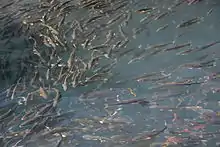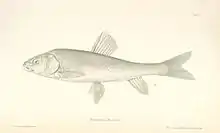Gymnocypris przewalskii
Gymnocypris przewalskii (common name: Przewalskii's naked carp; in Chinese: 青海湖裸鲤; lit. 'Qinghai Lake naked carp') is a species of cyprinid that is endemic to the Lake Qinghai basin in China, where it is the dominant fish species (the other natives are four Triplophysa loaches).[2][3] G. przewalskii is a planktivore with a main population that migrates from the lake to rivers to spawn[4] and another that lives its entire life in the nearby Ganzi River.[3] The species is listed as endangered on the China Species Red List due to overfishing and habitat loss, which has led to suspension of its commercial fishery four times since 1989.[4][5][6]
| Gymnocypris przewalskii | |
|---|---|
 | |
| Scientific classification | |
| Domain: | Eukaryota |
| Kingdom: | Animalia |
| Phylum: | Chordata |
| Class: | Actinopterygii |
| Order: | Cypriniformes |
| Family: | Cyprinidae |
| Subfamily: | Cyprininae |
| Genus: | Gymnocypris |
| Species: | G. przewalskii |
| Binomial name | |
| Gymnocypris przewalskii (Kessler, 1876) | |
| Synonyms | |
|
Schizopygopsis przewalskii Kessler, 1876[1] | |
Named in honor of geographer and explorer Nikolai Przhevalsky (also spelled Przewalski and Prjevalsky, 1839-1888), who collected the type species and in whose book about Mongolia Kessler’s description appeared.[7]
Characteristics

Naked carp reach a maximum length of 48 cm (1.57 ft) and are typically 300–500 g (0.66–1.10 lb) at reproductive age.[2][5] They feed mostly on benthic zooplankton about 2 m (6.6 ft) below the surface, though they also feed on other aquatic invertebrates.[8] They have long, flat bodies and almost no scales except near the anus and shoulder girdle, which gives them their common name. They grow relatively slowly and may take 7–10 years to reach reproductive size.[4][5]
Migration
The Qinghai Lake has a salinity of about 14 parts per thousand, meaning that the water is brackish.[3] From April to July adults of the lake population migrate 40–50 km (25–31 mi) to nearby freshwater streams to spawn. These include the Harge, Goncha, Chang Ji, and Buha rivers.[9] Much like salmon, they seek sandy gravel banks with slower currents to build nests.[9] When fish return to the lake, their electrolyte levels increase quickly to concentrations similar to Lake Qinghai's salinity, while urine flow, metabolic rate, and oxygen consumption all decrease drastically.[5] This is thought to represent the reduced osmoregulatory and metabolic costs of living in Lake Qinghai which make returning after spawning and reproduction advantageous. Young fish are thought to return to the lake after overwintering in their spawning streams.[9]
The other population spends its entire life in the nearby Ganzi River and is variously recognized as a separate ecotype or subspecies (G. p. ganzihonensis).[3] Although likely connected to Lake Qinghai in historical times, the low water levels have separated them, effectively isolating the naked barb in this river.[3] The two populations differ in shape and number of gill rakers.[3]
References
- "Gymnocypris przewalskii — Synonyms Scale-less Carp: Names". Encyclopedia of Life. Retrieved 7 June 2015.
- Froese, Rainer; Pauly, Daniel (eds.) (2014). "Gymnocypris przewalskii" in FishBase. November 2014 version.
- Zhang, Ludwig, Zhang, Tong, Li, Tang, Peng & Zhao (2015). Gymnocypris przewalskii (Cyprinidae) on the Tibetan Plateau. Scientific Reports 5, Article 9780.
- Xiong, Fei; Daqing Chen; Xinbin Duan (2010). "Threatened fishes of the world: Gymnocypris przewalskii (Kessler, 1876) (Cyprinidae: Schizothoracinae)". Environmental Biology of Fishes. 87 (4): 351–352. doi:10.1007/s10641-010-9609-x. S2CID 34978374.
- Wood, Chris M.; Jizeng Du; Joe Rogers; Colin J. Brauner; Jeffery W. Richards; Brent W. Murray; X.-Q. Chen; Yuxiang Wang (2007). "Przewalksii's naked carp (Gymnocypris przewalksii): An endangered species taking a metabolic holiday in Lake Qinghai, China". Physiological and Biochemical Zoology. 80 (1): 59–77. doi:10.1086/509212. PMID 17160880. S2CID 10372870.
- S. Wang, Y. Xie, ed. (2004). China Species Red List, vol 1. Beijing: Higher Education Press. p. 163.
- Christopher Scharpf & Kenneth J. Lazara (22 September 2018). "Order CYPRINIFORMES: Family CYPRINIDAE: Subfamilies ACROSSOCHEILINAE, BARBINAE, SPINIBARBINAE, SCHIZOTHORACINAE, SCHIZOPYGOPSINAE and Incertae sedis". The ETYFish Project Fish Name Etymology Database. Christopher Scharpf and Kenneth J. Lazara. Retrieved 10 March 2021.
- Chen, D.; Zhang, X.; Tan, X.; Wang, K.; Qiao, Y.; Chang, Y. (2009). "Hydroacoustic study of spatial and temporal distribution of Gymnocypris przewalskii (Kessler, 1876) in Qinghai Lake, China". Environmental Biology of Fishes. 84 (2): 231–239. doi:10.1007/s10641-008-9430-y. S2CID 30886346.
- Muir, James F. (1990). "Hatchery Development and Spawning Enhancement, Qinghai Lake". Fisheries Development in Qinghai Province. Food and Agricultural Organization of the United Nations. Retrieved 18 November 2012.